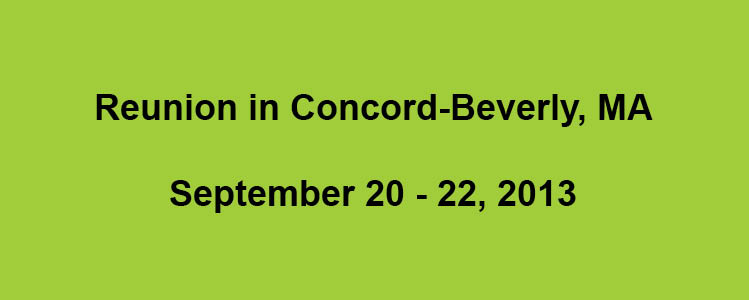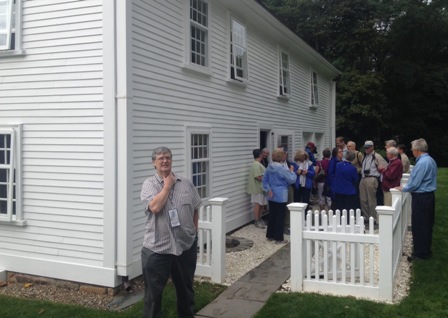Friday, September 20, 2013
Haskells from around the country and Canada gathered on Friday, September 20, 2013 at Concord's Colonial Inn for the beginning of a memorable reunion weekend. Edie Haskell and Debbie Young manned the registration table in the Prescott Room, where participants met on Friday afternoon to renew old friendships and make new acquaintances.
The evening festivities began at 6:00 p.m. with a cash bar reception in the downstairs Heritage Room. This was followed by a New England buffet dinner featuring New England clam chowder, Boston Bibb salad, New England baked chicken, Georges Bank scrod, Family Farms bistro steak, roasted potatoes, corn on the cob, and apple pie. Following dinner, Tammy Alfano from Harvard, MA gave a PowerPoint presentation on the Harvard Historical Society's Bateman Project. Harvard, MA (the town, not the university) is 16 miles west of Concord. The earliest settlements in the town took place in 1658 in the Village of Still River. Tammy described the history of the Haskell family within this community. She also brought with her the Haskell Family Quilt, which was made in 1867. Tammy's presentation was followed by a raffle in which members could select from an assortment of books and other items. These included two necklaces made by Edie Haskell, one containing the Haskell crest and the other the tree of life.
Dick Haskell gave a preview of the Saturday and Sunday activities. He identified the "Haskells who marched to the alarm" on April 19, 1775 and showed the towns from which they came. None of the towns were close enough to Concord and Lexington for a Haskell to get to those battles on time, but some Haskells ended up in Cambridge and took part of the siege of Boston during the rest of 1775.
Saturday, September 21, 2013
At 9:00 a.m., a bus picked us up in front of the Colonial Inn for a 4-hour guided tour of the Lexington-Concord battlefields. Our guide was Masha Traber, the director of the Lexington Liberty Ride tours. Her knowledge of the opening battles of the Revolutionary War and her engaging sense of humor made for a very enjoyable tour.
The bus headed back to Lexington, where the first encounter between the Colonial patriots and the British regulars took place on the early morning on April 19, 1775. The bus followed the route taken later that day by the British retreat from Concord. On the Lexington green, our guide, Masha Traber, told us the story of how the British regulars marched from Boston late in the evening of April 18, 1775 and arrived at the Lexington green about 5:00 a.m. on April 19th. About 70 minutemen under the command of Captain John Parker had assembled on the Lexington green, having been alerted by Paul Revere and William Dawes shortly after midnight that "the Regulars are coming." A shot of unknown origin rang out, and when the smoke cleared, eight militia men had been killed by the British regulars.
We then moved to the southern part of the Lexington green where the story continued at the foot of the monument of the Lexington militia. Across the street, on the front lawn of the Lexington Visitor's Center, a craft show was underway, and we took a break to enjoy the craft show and check out the Visitor's Center. Back on the bus, we made our way to the Hartwell tavern in Lincoln, which is on the road that the British regulars followed on their way from Lexington to Concord and on their way back to Boston later that day. Here we witnessed a musket demonstration by a Park Ranger.
We then continued on to the Concord Bridge, which is about a mile north of the Colonial Inn. Seated on benches next to the bridge, Masha told us the story of the critical battle at the bridge, where the first casualties of the British regulars occurred. After crossing the bridge to see the Minuteman Monument, and stopping at the Grave of British Soldiers, we got on the bus just as a long line of motorcycles that were part of the Wounded Warrior Project passed by headed in the direction of the Colonial Inn. After backing up our bus with great skill, our bus driver turned around and headed out in the opposite direction, taking us back to the Colonial Inn by a back way that went around the back side of the Concord bridge battlefield. Thus, ended an excellent guided tour of the battlefields that started a long six-year effort that finally ended with a victory at Yorktown.
On Saturday afternoon and evening, we were all on our own. Some of us had lunch at Helen's, just across the street from the Concord green. There is almost always a waiting line at Helen's at lunch time, but the large assortment of great sandwiches makes the wait worthwhile. Some of us spent the afternoon at the Colonial Inn resting and meeting with our Haskell cousins. Others used the time to visit some of the many historic sites in the Concord area. Carey took photos of the Wright Tavern that played an important role on April 19, 1775. He also visited the Sleepy Hollow Cemetery on Bedford Street, which, among others, contains the graves of Henry David Thoreau, Nathaniel Hawthorne, Louisa May Alcott, and Ralph Waldo Emerson. Not far from the center of Concord is the home of Ralph Waldo Emerson, where he lived from 1835-1882. Across the street from the Emerson home is the Concord Museum, which contains Thoreau's desk and an exact reproduction of Emerson's study. It also contains one of the two lanterns that were hung in the belfry of the Old North Church in Boston to signal to Paul Revere that the British regulars would be crossing Boston harbor on their way to Lexington. A little further out on Lexington Road in the Orchard House where Louisa May Alcott wrote Little Women. By Saturday night, we were all pretty tired and ready for a good night's sleep in preparation for more activities in Beverly on Sunday.































































































































